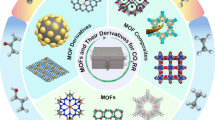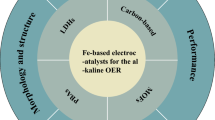Abstract
Preparing low-cost and metal-free catalysts with outstanding catalytic activity and high stability to replace noble metal catalysts is the current development trend. Herein, a facile and low-cost two-step carbonization is proposed for the preparation of N, S-codoped oxygen reduction reaction (ORR) electrocatalysts, PP350KOH800-S, from the biomass waste pomelo peel by introducing KOH and thiourea as activator. The prepared electrocatalysts have the high specific surface area and the hierarchical porous structure and exhibit excellent ORR catalytic activity with the half-wave potential of 0.87 V and the limiting diffusion current density of −7.2 mA cm−2 in alkaline media. The excellent ORR electrocatalytic activity largely depends on the large specific surface area, the porous structure, the high degree of defects, and the synergistic effect of nitrogen and sulfur atoms. The present work provides a reliable method for the preparation of cheap and effective electrocatalysts using biomass waste.






Similar content being viewed by others
References
Gong K, Du F, Xia Z, Durstock M, Dai L (2009) Nitrogen-doped carbon nanotube arrays with high electrocatalytic activity for oxygen reduction. Science 323(5915):760–764
Debe MK (2012) Electrocatalyst approaches and challenges for automotive fuel cells. Nature 486(7401):43–51
Zhang Z, Deng Y-P, Xing Z, Luo D, Sy S, Can ZP, Liu G, Jiang Y, Chen Z (2019) “Ship in a bottle” design of highly efficient bifunctional electrocatalysts for long-lasting rechargeable Zn–Air batteries. ACS Nano 13(6):7062–7072
Kwon NH, Conder J, Srout M, Fromm KM (2019) Surface modifications of positive-electrode materials for lithium ion batteries. Chimia 73(11):880–893
Huang Z-F, Wang J, Peng Y, Jung C-Y, Fisher A, Wang X (2017) Design of efficient bifunctional oxygen reduction/evolution electrocatalyst: recent advances and perspectives. Adv Energy Mater 7(23):1700544
Dai L, Xue Y, Qu L, Choi H-J, Baek J-B (2015) Metal-free catalysts for oxygen reduction reaction. Chem Rev 115(11):4823–4892
Yu Z-Y, Duan Y, Liu J-D, Chen Y, Liu X-K, Liu W, Ma T, Li Y, Zheng X-S, Yao T, Gao M-R, Zhu J-F, Ye B-J, Yu S-H (2019) Unconventional CN vacancies suppress iron-leaching in Prussian blue analogue pre-catalyst for boosted oxygen evolution catalysis. Nat Commun 10(1):2799
Dutta A, Bizzotto F, Quinson J, Zana A, Morstein CE, Rahaman MA, López AC, Arenz M, Broekmann P (2019) Catalyst development for water/CO2 co-electrolysis. Chimia 73(9):707–713
Zhou M, Wang H-L, Guo S (2016) Towards high-efficiency nanoelectrocatalysts for oxygen reduction through engineering advanced carbon nanomaterials. Chem Soc Rev 45(5):1273–1307
Zhou T, Xu W, Zhang N, Du Z, Zhong C, Yan W, Ju H, Chu W, Jiang H, Wu C, Xie Y (2019) Ultrathin cobalt oxide layers as electrocatalysts for high-performance flexible Zn–Air batteries. Adv Mater 31(15):1807468
Wood KN, O’Hayre R, Pylypenko S (2014) Recent progress on nitrogen/carbon structures designed for use in energy and sustainability applications. Energy Environ Sci 7(4):1212–1249
Yang Z, Nie H, Chen XA, Chen X, Huang S (2013) Recent progress in doped carbon nanomaterials as effective cathode catalysts for fuel cell oxygen reduction reaction. J Power Sources 236(16):238–249
Ge H, Li G, Shen J, Ma W, Meng X, Xu L (2020) Co4N nanoparticles encapsulated in N-doped carbon box as tri-functional catalyst for Zn-air battery and overall water splitting. Appl Catal B 275:119104
Silva R, Voiry D, Chhowalla M, Asefa T (2013) Efficient metal-free electrocatalysts for oxygen reduction: polyaniline-derived N- and O-Doped mesoporous carbons. J Am Chem Soc 135(21):7823–7782
Ma Z, Dou S, Shen A, Tao L, Dai L, Wang S (2015) Sulfur-doped graphene derived from cycled lithium-sulfur batteries as a metal-free electrocatalyst for the oxygen reduction reaction. Angew Chem Int Ed 54(6):1888–1892
El-Sawy AM, Mosa IM, Su D, Guild CJ, Khalid S, Joesten R, Rusling JF, Suib SL (2016) Controlling the active sites of sulfur-doped carbon nanotube-graphene nanolobes for highly efficient oxygen evolution and reduction catalysis. Adv Energy Mater 6(5):1501966
Zhang M, Dai L (2012) Carbon nanomaterials as metal-free catalysts in next generation fuel cells. Nano Energy 1(4):514–517
Zeng H, Wang W, Li J, Luo J, Chen S (2018) In situ generated dual-template method for Fe/N/S co-doped hierarchically porous honeycomb carbon for high-performance oxygen reduction. ACS Appl Mater Interfaces 10(10):8721–8729
Li Y, Guo Q, Jiang Y, Shen W, Li M, He R (2020) A novel ball-in-ball hollow oxygen-incorporating cobalt sulfide spheres as high-efficient electrocatalyst for oxygen evolution reaction. Chin Chem Lett. https://doi.org/10.1016/j.cclet.2020.05.012
Li Q, Chen W, Xiao H, Gong Y, Li Z, Zheng L, Zheng X, Yan W, Cheong WC, Shen R (2018) Fe isolated single atoms on S, N codoped carbon by copolymer pyrolysis strategy for highly efficient oxygen reduction reaction. Adv Mater 30(25):1800588
Jeon IY, Zhang S, Zhang L, Choi HJ, Seo JM, Xia Z, Dai L, Baek JB (2013) Edge‐selectively sulfurized graphene nanoplatelets as efficient metal‐free electrocatalysts for oxygen reduction reaction: the electron spin effect. Adv Mater 25(42):6138–6145
Hao Y, Zhang X, Yang Q, Chen K, Guo J, Zhou D, Feng L, Slanina Z (2018) Highly porous defective carbons derived from seaweed biomass as efficient electrocatalysts for oxygen reduction in both alkaline and acidic media. Carbon 137:93–103
Xia BY, Yan Y, Li N, Wu HB, Lou XWD, Wang X (2016) A metal–organic framework-derived bifunctional oxygen electrocatalyst. Nat Energy 1(1):15006
Li J-C, Hou P-X, Zhao S-Y, Liu C, Tang D-M, Cheng M, Zhang F, Cheng H-M (2016) A 3D bi-functional porous N-doped carbon microtube sponge electrocatalyst for oxygen reduction and oxygen evolution reactions. Energy Environ Sci 9(10):3079–3084
Mai W, Sun B, Chen L, Xu F, Liu H, Liang Y, Fu R, Wu D, Matyjaszewski K (2015) Water-dispersible, responsive, and carbonizable hairy microporous polymeric nanospheres. J Am Chem Soc 137(41):13256–13259
Ding W, Li L, Xiong K, Wang Y, Li W, Nie Y, Chen S, Qi X, Wei Z (2015) Shape fixing via salt recrystallization: a morphology-controlled approach to convert nanostructured polymer to carbon nanomaterial as a highly active catalyst for oxygen reduction reaction. J Am Chem Soc 137(16):5414–5420
Zhang P, Bin D, Wei J-S, Niu X-Q, Chen X-B, Xia Y-Y, Xiong H-M (2019) Efficient oxygen electrocatalyst for Zn–air batteries: carbon dots and Co9S8 nanoparticles in a N,S-codoped carbon matrix. ACS Appl Mater Interfaces 11(15):14085–14094
Wang L, Liang K, Deng L, Liu Y-N (2019) Protein hydrogel networks: a unique approach to heteroatom self-doped hierarchically porous carbon structures as an efficient ORR electrocatalyst in both basic and acidic conditions. Appl Catal B 246:89–99
Li G, Pei L, Wu Y, Zhu B, Hu Q, Yang H, Zhang Q, Liu J, He C (2019) Facile synthesis of polyacrylonitrile-based N/S-codoped porous carbon as an efficient oxygen reduction electrocatalyst for zinc–air batteries. J Mater Chem A 7(18):11223–11233
Zhao Y, Wan J, Yao H, Zhang L, Lin K, Wang L, Yang N, Liu D, Song L, Zhu J, Gu L, Liu L, Zhao H, Li Y, Wang D (2018) Few-layer graphdiyne doped with sp-hybridized nitrogen atoms at acetylenic sites for oxygen reduction electrocatalysis. Nat Chem 10(9):924–931
Shin J, Guo J, Zhao T, Guo Z (2019) Functionalized carbon dots on graphene as outstanding non-metal bifunctional oxygen electrocatalyst. Small 15(16):1900296
Xing L, Song C, Kong A (2020) N–S-codoped mesoporous carbons from melamine-2-thenaldehyde polymers on carbon nanotubes for oxygen reduction and Zn-air batteries. J Solid State Chem 287:121348
Ma R, Lin G, Zhou Y, Liu Q, Zhang T, Shan G, Yang M, Wang J (2019) A review of oxygen reduction mechanisms for metal-free carbon-based electrocatalysts. NPJ Comput Mater 5(1):78
Ito Y, Cong W, Fujita T, Tang Z, Chen M (2015) High catalytic activity of nitrogen and sulfur co-doped nanoporous graphene in the hydrogen evolution reaction. Angew Chem Int Ed 54(7):2131–2136
Kohila Rani K, Karuppiah C, Wang SF, Alaswad SO, Sireesha P, Devasenathipathy R, Jose R, Yang CC (2020) Direct pyrolysis and ultrasound assisted preparation of N, S co-doped graphene/Fe3C nanocomposite as an efficient electrocatalyst for oxygen reduction and oxygen evolution reactions. Ultrason Sonochem 66:105111
Ni B, Chen R, Wu L, Xu X, Shi C, Sun P, Chen T (2020) Optimized enhancement effect of sulfur in Fe–N–S codoped carbon nanosheets for efficient oxygen reduction reaction. ACS Appl Mater Interfaces 12(21):23995–24006
Fang W, Bai Z, Yu X, Zhang W, Wu M (2020) Pollen-derived porous carbon decorated with cobalt/iron sulfide hybrids as cathode catalysts for flexible all-solid-state rechargeable Zn–air batteries. Nanoscale 12(21):11746–11758
Ma Y, You S, Jing B, Xing Z, Chen H, Dai Y, Zhang C, Ren N, Zou J (2019) Biomass pectin-derived N, S-enriched carbon with hierarchical porous structure as a metal-free catalyst for enhancing bio-electricity generation. Energy 44(31):16624–16638
An L, Yan H, Chen X, Li B, Xia Z, Xia D (2016) Catalytic performance and mechanism of N-CoTi@CoTiO3 catalysts for oxygen reduction reaction. Nano Energy 20:134–143
Liang J, Zheng Y, Chen J, Liu J, Hulicova-Jurcakova D, Jaroniec M, Qiao SZ (2012) Facile oxygen reduction on a three-dimensionally ordered macroporous graphitic C3N4/carbon composite electrocatalyst. Angew Chem Int Ed Eng 51(16):3892–3896
Jin J-T, Qiao X-C, Cheng F-L, Fan H-B, Cui L-F (2017) Direct synthesis of interconnected N, S-codoped porous exfoliated carbon nanosheets as advanced electrocatalysts for oxygen reduction reaction. Carbon 122:114–121
Wang H, Maiyalagan T, Wang X (2012) Review on recent progress in nitrogen-doped graphene: synthesis, characterization, and its potential applications. ACS Catal 2(5):781–794
Yasuda S, Yu L, Kim J, Murakoshi K (2013) Selective nitrogen doping in graphene for oxygen reduction reactions. Chem Commun 49(83):9627–9629
Wu J, Ma L, Yadav RM, Yang Y, Zhang X, Vajtai R, Lou J, Ajayan PM (2015) Nitrogen-doped graphene with pyridinic dominance as a highly active and stable electrocatalyst for oxygen reduction. ACS Appl Mater Interfaces 7(27):14763–14769
Naveen MH, Shim K, Hossain MSA, Kim JH, Shim Y-B (2017) Template free preparation of heteroatoms doped carbon spheres with trace Fe for efficient oxygen reduction reaction and supercapacitor. Adv Energy Mater 7(5):1602002
Acknowledgements
The authors acknowledge the generous financial support from Natural Science Foundation of Chongqing (cstc2018jcyjAX0625).
Author information
Authors and Affiliations
Corresponding author
Ethics declarations
Conflict of interest
The authors declare no competing interests.
Additional information
Publisher’s note
Springer Nature remains neutral with regard to jurisdictional claims in published maps and institutional affiliations.
Supplementary Information
ESM 1
(DOCX 1.09 mb).
Rights and permissions
About this article
Cite this article
Gao, Q., Wang, Y., Yang, M. et al. N, S-codoped porous carbon as metal-free electrocatalyst for oxygen reduction reaction. J Solid State Electrochem 25, 1765–1773 (2021). https://doi.org/10.1007/s10008-021-04947-5
Received:
Revised:
Accepted:
Published:
Issue Date:
DOI: https://doi.org/10.1007/s10008-021-04947-5




